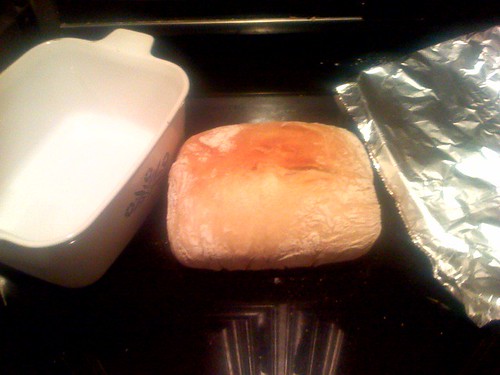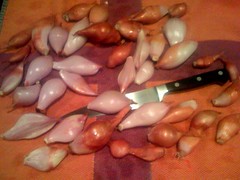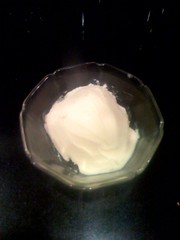Tuesday, November 27, 2007
housekeeping note
I am posting a lot less on my own garden than I would like. This is because, in part, we have a new baby on the way, which means that I have lots of projects to complete, such as painting a three-colored striped nursery, before said offspring arrives. The consequence is that I have not finished building the second set of beds and "dug into" planting everything yet. Anyway, that's all coming soon, I hope. I think that over Christmas break while waiting for the youngin' to arrive, I may have some time to move these projects forward.
Organic at all Scales

One of the challenges that I think will ultimately face the organic movement as it continues to grow is what to do with large-scale commodity crops. Many would challenge the fundamental notion that there even should be such a thing, but given that cheap commodity crops are an integral part of our food system, organic does need an effective approach. I am not implying that it doesn't. It's just that most of the organic efforts that I am familiar with, focus on higher value vegetable crops, and to a lesser degree, milk & meat.
This article raises this question in many ways, taking it even further with the issue of Genetic Engineering to make sugar beets. Sugar beets is a clever crop, because unlike most GE crops to date, there is no residual DNA in the final product, sugar, that can be pointed to as the immediate threat, as was the case with GE corn and wheat. Additionally, using GE beets will result in a 40-50% decrease in use of pesticides, at least in the short term.
I would love input. Are there organic sugar beet farmers out there? How do they deal with weeds? Can they intercrop, or cover crop to deal with it?
Organic at all Scales

One of the challenges that I think will ultimately face the organic movement as it continues to grow is what to do with large-scale commodity crops. Many would challenge the fundamental notion that there even should be such a thing, but given that cheap commodity crops are an integral part of our food system, organic does need an effective approach. I am not implying that it doesn't. It's just that most of the organic efforts that I am familiar with, focus on higher value vegetable crops, and to a lesser degree, milk & meat.
This article raises this question in many ways, taking it even further with the issue of Genetic Engineering to make sugar beets. Sugar beets is a clever crop, because unlike most GE crops to date, there is no residual DNA in the final product, sugar, that can be pointed to as the immediate threat, as was the case with GE corn and wheat. Additionally, using GE beets will result in a 40-50% decrease in use of pesticides, at least in the short term.
I would love input. Are there organic sugar beet farmers out there? How do they deal with weeds? Can they intercrop, or cover crop to deal with it?
uncomfortable
nothing to do with gardening, but I am a non-confrontational kind of guy and this picture just makes me go nuts internally. Political leanings aside, this wasn't fun for anyone!


Thursday, November 22, 2007
Happy Thanksgiving!

This is a string of drying peppers that I picked out of the garden last week as I was cleaning up. I didn't have an immediate need for them, so I hung them on a string.
A few days later, I remembered that I am bringing ceviche to my family's Thanksgiving party. This is the appetizer that I am forever required to bring to family holidays. Success breeds not just success but demand for repeat performances! I cut three peppers off the string and used them. I will also be putting sungold cherry tomatoes that just ripened into the mix. I have some baby cilantro that did not quite make the cut.
As for drying the peppers, this is a pretty cool way to go. We have it hanging in our kitchen and it looks nice. As soon as I got them strung up, they began changing colors to red. I took a turkey "pin", straightened out the loop for stringing, used it as an oversized needle and strung up the chilies.
Friday, November 16, 2007
Toaster Oven No-Knead Bread!
If you read any food blogs, and if you are reading this blog, then you almost certainly do, then you have heard endlessly about the famous "No-Knead" bread. Heck, you have probably made a few batches yourself. I have made this bread quite a lot as well. One type of comment that seems to come up a lot, particularly on bread-focused blogs/websites is, "Why do people like this recipe so much, I've been making wet dough types of bread for years..." I have thought about this because prior to this recipe, and I can't say that I made a lot of bread.
I think that the answer is that this recipe is in the tradition of "pure" bread recipes (i.e. those consisting of water, flour, yeast & salt), yet is nearly effortless and is VERY FORGIVING. When I realized this, I thought, "Well, how forgiving is it?" So, I thought, let's try it in the Toaster oven. Because, frankly if you can make a credible rustic loaf of bread with a crackly crust and moist interior in the toaster oven, well, you have something there!
So, I found a casserole dish that could hold a recipe based on 2 cups of flour. I made a 4 cup recipe (I work approximately from this variation, which I think has even more of a nutty, bready flavor), split it in half and ran the other half as a control in the oven. I should note that my toaster oven is the $49.99 special at Target. No fancy convections or ceramics here!
So, here is my toaster oven running at ~400º with tin foil as a top:

and here after 30 minutes covered & 10 minutes uncovered is the loaf:

I will report this so far as a partial success. Unfortunately, I did not have instant yeast and I hadn't noticed that until my control loaf was also a little dense and "not quite right", so I will try again. But given that, this is a very auspicious sign. Smeared with butter and hot, this was bread that 90% of most people would find "fantastic".
A TOASTER OVEN!
Originally uploaded by chris brandow
I think that the answer is that this recipe is in the tradition of "pure" bread recipes (i.e. those consisting of water, flour, yeast & salt), yet is nearly effortless and is VERY FORGIVING. When I realized this, I thought, "Well, how forgiving is it?" So, I thought, let's try it in the Toaster oven. Because, frankly if you can make a credible rustic loaf of bread with a crackly crust and moist interior in the toaster oven, well, you have something there!
So, I found a casserole dish that could hold a recipe based on 2 cups of flour. I made a 4 cup recipe (I work approximately from this variation, which I think has even more of a nutty, bready flavor), split it in half and ran the other half as a control in the oven. I should note that my toaster oven is the $49.99 special at Target. No fancy convections or ceramics here!
So, here is my toaster oven running at ~400º with tin foil as a top:

and here after 30 minutes covered & 10 minutes uncovered is the loaf:

I will report this so far as a partial success. Unfortunately, I did not have instant yeast and I hadn't noticed that until my control loaf was also a little dense and "not quite right", so I will try again. But given that, this is a very auspicious sign. Smeared with butter and hot, this was bread that 90% of most people would find "fantastic".
A TOASTER OVEN!
Originally uploaded by chris brandow
Monday, November 12, 2007
Fall Tomatoes

I love veggie gardening in So. Cal! It is Nov. 13 and I have a Sungold cherry tomato plant covered in full-sized green tomatoes that will be ripe very soon. I also have another Carmelo plant that will be ripe soon as well. I have never left my tomato plants out this late. Mostly, I just hadn't gotten to it yet. Yeah for me! We'll see how they turn out.
PS. The recently planted Saffron Crocuses have mostly sprouted and will hopefully be flowering soon. Updates to follow!
Les Echalotte

Now it might be hard to get the scale, but these are big ole' shallots. That is my large kitchen knife nestled among them for scale. To my eyes looking at the picture, it looks like my paring knife!
These are shallots that I harvested in the summer and had not gotten around to planting yet. I finally planted some of them last night and these are the leftovers. I have offered some as seed to friends, and I think that I might cook up some of the others for dinner tonight. I am going to try to caramelize the. I've never done that and it might be fun!
The best part about shallots is that for such a seemingly "fancy" vegetable, they are probably one of the easiest of all to grow. Stick a single clove ~3 inches below ground, water and wait until June-July and pull out a large mass of huge cloves. No pests, no problems. They also send up cool allium "blossoms" that are fun to look at, though I tend to cut them out so that they don't retard the growth of the cloves.
I bought my first sets from www.kitchengardenseeds.com
Originally uploaded by chris brandow
Thursday, November 8, 2007
From Scratch

One of my favorite cooking activities is making very basic foods from scratch. In this case, a friend sent an article by the head chef at Coi about making butter from scratch, something that I have done before, but not well. The article was great because it gave insight into this highly regarded chef at a "super-fabulous" restaurant who didn't even know how to make butter at first.
The butter was indeed easy to make & yummy, but again, for me there is something so fundamental about making simple things. This is in line with making vinegar from leftover wine: super-yummy, super-easy; roasting coffee beans: nothing fresher; making bread; and of course, growing one's own food, especially the unusual fruits and vegetables that you could never find in a grocery store or even many farmes markets.
Often, it is decidedly cheaper to make things from scratch. Not in this case, but it is still way tastier and a lot more fun!
Originally uploaded by chris brandow
Tuesday, November 6, 2007
Monday, November 5, 2007
Lactuca Sativa
One of the greatest things to grow in the home garden is lettuce. There is simply no way to match the amazing variety and texture that you get from home grown lettuce. Simply great.
You may not realize that lettuce is descendant of dandelions or at least run very close in the same family. Well, I just ran across a couple of "volunteer" lettuce plants (seemingly of the delicious "Blushed Butter Oak" variety that sprang up in the sideyard next to a dandelion just to make the comparison clear.
I will let them grow up a bit, and them clip them for the salad bowl
You may not realize that lettuce is descendant of dandelions or at least run very close in the same family. Well, I just ran across a couple of "volunteer" lettuce plants (seemingly of the delicious "Blushed Butter Oak" variety that sprang up in the sideyard next to a dandelion just to make the comparison clear.

I will let them grow up a bit, and them clip them for the salad bowl
Friday, November 2, 2007
Agriculture policy part I of many to come
I have been ruminating on agricultural policy lately, and before I can get to my full-blown thoughts, I will need to lay the groundwork. This single graphic does so in stunningly simple fashion:

We give away a ton of money to make certain foods cheap: corn, soybeans, meat & milk. The question that I really want to grapple with is whether this is good. Certainly many people are cataloging the problems, but what about the upsides?

We give away a ton of money to make certain foods cheap: corn, soybeans, meat & milk. The question that I really want to grapple with is whether this is good. Certainly many people are cataloging the problems, but what about the upsides?
Subscribe to:
Posts (Atom)
